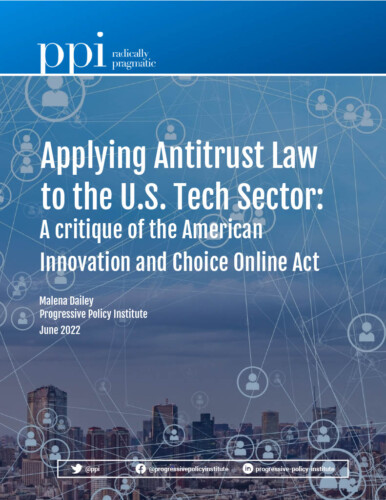Applying Antitrust Law to the U.S. Tech Sector: A critique of the American Innovation and Choice Online Act
By: / 06.28.2022
Download PDFEXECUTIVE SUMMARY
In 2019, the House Judiciary Committee initiated an investigation into the state of competition in digital markets, looking particularly at the dominance of America’s biggest online platforms. Three years later, a slew of bills have been introduced at both federal and state level intended to curb the power of “Big Tech.” The driving force behind many of these efforts is the claim that companies like Google, Amazon, Facebook (Meta), and Apple are simply too big, with their size posing a competitive threat to smaller tech companies. A handful of these bills are being introduced with the purpose of updating America’s antitrust laws to meet the challenge of today’s supposed tech monopolies.
The American Innovation and Choice Online Act (S. 2992) sponsored by Senators Amy Klobuchar, D-Minn., and Chuck Grassley, R-Iowa, for example, is being sold to Congress and the American public as being comprehensive antitrust legislation to rein in the power of “Big Tech.” Whatever its merits, however, the bill isn’t really based in antitrust law and policy. Rather, it’s an ad hoc set of new rules which replace the current standards for antitrust enforcement based on market power and consumer welfare with a more generalized approach which targets just one industry — online platforms. The Senate bill looks at platforms with a large number of users and assumes excessive market power as a result of size, forgoing the need for economic analysis required to prove illegal monopoly power. The bill then imposes additional competitive requirements onto this predetermined set of companies.
A genuine antitrust analysis would examine not just firm size, but the conditions of the market in which a company operates, the presence of direct competitors, and its potential for consumer harm. Instead, the Senate bill takes a cookie cutter approach to antitrust enforcement: An online platform that hosts third party business users with over 50 million U.S. monthly active users (or 100,000 business users) and a market capitalization or net annual sales over $550 billion should be subject to different rules regarding competition. Essentially, a company-specific carveout without precedent in antitrust law.
There is a demonstrated need for changes in how antitrust law is enforced in order to encompass the business models of today’s digital platforms and e-commerce sites. However, the Senate bill fails to offer a rigorous economic analysis of digital markets, fundamentally changing enforcement methods in ways unacknowledged by the bill’s supporters.
This report explores three ways in which the Senate bill falls short:
• For the past 40 years, U.S. antitrust enforcement has been based on the assessment of quantifiable harm resulting from a firm’s market power, which most often takes the form of price effects. Supporters of the Senate bill, however, make no such assessment.
• In addition to being incompatible with current antitrust law and practice, the American Innovation and Choice Online Act’s size-based model would put American companies at a competitive disadvantage against other big competitors in global markets.
• Businesses such as internet platforms with low costs and significant network effects require a more sophisticated approach to examining consumer harm which accounts for damage to consumers other than rising prices. This might include adverse changes to company policies or reduction in accessibility of a service and may, in the end, warrant additional regulation. The current proposed legislation does not make such a case.
Today’s dominant technology companies may warrant scrutiny under antitrust law, but to investigate the merits of this claim it is critical that assessment of an illegal monopoly is based on market power rather than size. By considering metrics of consumer harm beyond price effects, it is possible to evaluate harmful market power in a way that considers the nature of these growing industries without discounting the additional value to the consumer presented by companies with large network effects.


